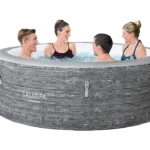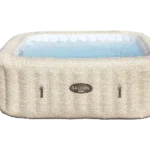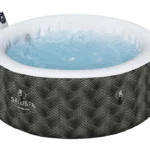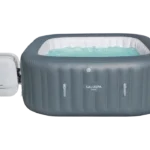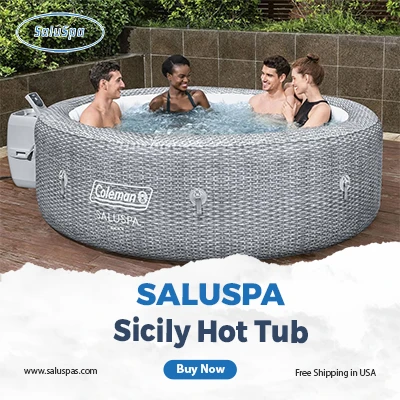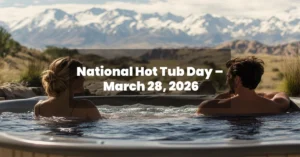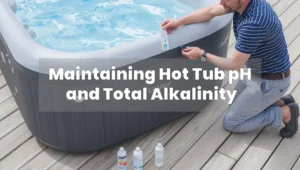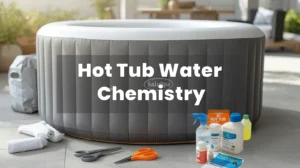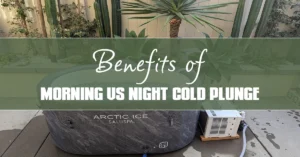Your hot tub might freeze and break this winter, but insulation does the magic, and you can run your SaluSpa efficiently and warmly with proper insulation techniques. Insulating your inflatable hot tub does not only save energy costs but prevents it from freezing which would otherwise damage vital parts hence a longer lifespan. Everything you need to know is in that manual on how to winterize your SaluSpa hot tub. It delves into Freeze Shield technology, various insulation approaches for your inflatable hot tub, as well as how to maintain it.
Introduction: The Importance of Insulating Your SaluSpa Hot Tub
A SaluSpa hot tub is by far the most convenient way to enjoy and relax one’s body with a spa experience right in your very backyard. Of course, this is quite a heavy burden to your inflatable spa during the cold season. If it’s not properly insulated, then odds are it won’t be able to maintain water at an ideal temperature. This will cost you even more, not to mention the worst part of it all, it could freeze and break.
Proper insulation of your hot tub will enable it to withstand the freezing temperatures and ensure that it does not consume much power. This is how to insulate your hot tub; for commercial and domestic purposes. It also imparts essential winterizing tips to maintain your spa in excellent conditions.
What is SaluSpa’s Freeze Shield Technology?
Many SaluSpa models have Freeze Shield technology – which means that they won’t be ruined if they freeze. This feature prevents the freezing of not only the water in the tub but also the pump and plumbing lines when weather conditions get cold. The Freeze Shield system automatically activates when temperatures outside drop. It keeps the water in the spa between 5.5°C and 10°C even when the temperature outdoors falls to -10°C, for example, as low as 14°F.
Key Benefits of Freeze Shield Technology
-
- Year-round use: You can use your SaluSpa in the winter, even when it’s below freezing.
-
- Automatic freeze protection: It stops water, lines, and pumps from freezing on their own, so you don’t have to do anything.
-
- Convenience: You don’t have to change the settings or keep an eye on the temperature of your spa all the time.
Freeze Shield does a great job of protecting, but you should still look for ways to improve your insulation for the best results and savings.
Insulation Strategies for Inflatable Hot Tubs
Proper insulation is important for keeping heat in, making your SaluSpa more energy efficient, and keeping it from freezing. Here are some ideas for how to keep different parts of your inflatable hot tub warm.
A. Top Insulation: Covers and Blankets
One of the best ways to keep your hot tub warm is to make sure the insulation is good on top. The water’s surface loses heat, so it’s important to use a thick, insulated cover.
-
- EnergySense Insulated Cover / Thermal Cover Upgrade: Obtain a dense, rounded cap with locking straps that adequately fits, ideally 5 to 6 inches thick. A correctly fitting insulated cap will help maintain heated water for a more extended period by halting heat’s escape to the surface.
-
- Floating Thermal Blanket (Solar Blanket): For even longer heat retention, place a floating thermal blanket or solar cover directly on the water under the main cover. These blankets are specifically designed to insulate retain heat, decrease evaporation and waste less heat to the atmosphere.
B. Side Insulation: Jackets and Wraps
Side insulation can add an extra layer of protection around the walls of the tub in addition to top insulation.
-
- Commercial Insulation Jacket for Inflatable Spa: You can also purchase foam or reflective jackets that wrap around your spa’s sides to keep it insulated even more. For long-lasting jackets, look for a waterproof, and UV- resistant shell. Most of the time, they come in Velcro or zipper to wear it easily.
-
- DIY Options:
Some have even constructed jackets themselves out of bubble wrap or rolls of aluminum. These rough-and-ready solutions may suffice in a pinch, but the jackets made in the factory are both stronger and much better insulators.
- DIY Options:
C. Bottom Insulation: Mats, Foam Boards, and Platforms
It’s important to insulate the ground under your hot tub well because it can hold a lot of heat. There are different ways to do this:
-
- Insulated Ground Mat / Hot Tub Pad:
Put an insulated mat or hot tub pad under the hot tub so it doesn’t lose its heat into the ground. These mats are very easy to set down and also provide a nice soft seating surface for your hot tub so the base does not get so worn out.
- Insulated Ground Mat / Hot Tub Pad:
-
- Foam Board Under Hot Tub:
Opt for better insulation as rigid foam boards have R-values ranging from 3.6 to 4.7 per inch. These foam boards can be placed directly under the spa or incorporated into the construction of a raised platform. This will trap the heat and level off the tub.
- Foam Board Under Hot Tub:
-
- Platform Setup:
Construct a raised platform using wood or composite materials and place foam or reflective insulation underneath. A raised platform would keep your spa above the cold ground and stay dry.
- Platform Setup:
D. Pump & Hose Freeze Protection
Use extra insulation methods to keep your spa’s pump and hoses from freezing when it’s very cold outside.
-
- Pump Insulation:
Keep the pump insulated against freezing and heat loss with a pump insulation jacket. They usually have foam or reflective layers inside the weatherproof shell.
- Pump Insulation:
-
- Hose Protection:
Wrap exposed hoses with foam pipe insulation or heat tape to keep your hoses safe, especially in the wind or very cold.
- Hose Protection:
Additional Winterizing Tips
There are a few more tips for winterizing your SaluSpa hot tub that will help it keep heat and keep it safe from the weather.
A. Hot Tub Heat Retention & Energy Efficiency
-
- Keep the spa covered when not in use: When you’re not using the spa, keep the cover on to keep the heat in and use less energy.
-
- Maintain a steady water temperature: Don’t let the water cool down and then heat it up again, because this uses more energy. Keeping the temperature steady is more efficient.
-
- Shield from wind: Put up fencing, screens, or even shrubs around your spa to keep cold winds from getting in and making it lose a lot of heat.
-
- Clear snow from the cover: Snow accumulates on the lid, weighing it down and letting more of the heat out. To keep it working right, be sure to push or remove the snow off the lid.
B. Chemical and Filter Maintenance
During the winter, it’s important to keep the water chemistry and filters in your spa in good shape so that it works well and lasts a long time.
-
- Regularly check and balance chemicals:
-
- pH: 7.4–7.6
-
- Alkalinity: 80–120 ppm
-
- Calcium hardness: 200–400 ppm
-
- Chlorine: 2.0–4.0 ppm
-
- Regularly check and balance chemicals:
-
- Check and clean your filters often to make sure that your system stays clean and that water flows properly.
C. When NOT to Use in Extreme Cold
It’s much better to drain, clean, and store your spa if the temperature is going to drop well below the protection range of the Freeze Shield for any length of time (below 14°F), to keep it from freezing.
-
- Storage Tips: Bring the spa inside (if you can) or store it away if you are going to be gone for a long time or if the weather is extremely cold.
DIY vs. Commercial Insulation Kits
You have two main choices for insulating your SaluSpa: do it yourself or buy a commercial insulation kit. There are pros and cons to each method.
DIY Methods:
-
- Materials: You can use fiberglass, cellulose, spray foam, bubble wrap, or aluminum rolls to make your own insulation.
-
- Pros: DIY insulation is cheaper and can be made to fit your needs.
-
- Disadvantages: These ‘ll not last as long or work as well as others, even though they can save money. Some materials, like fiberglass, ‘ll also be tough to work with.
Commercial Kits:
-
- Designed for Hot Tubs: Ready-made commercial insulation kits exist for hot tubs; they are easy to fit and generally more weatherproof and durable.
-
- Spray Foam Insulation: Professional spray foam insulation is the best at keeping air out. It also has the highest R value. It’s also the most expensive in the long run.
Energy Cost Considerations
It costs energy to heat your SaluSpa in the winter, but good insulation can help keep those costs down.
-
- Typical daily energy use: 10–20 kWh depending on the level of insulation and how often you use the spa.
-
- Estimated cost: At $0.12 per kWh, running your SaluSpa could cost around $1.80–$2.40 per day, or $54–$72 per month in winter. Heating from cold (e.g., from 50°F to 100°F) could cost $5–$6 per session.
Keeping the temperature steady and using good insulation can cut these heating costs by a lot.
User Experiences & Practical Advice
-
- The most important part of keeping heat in is the top insulation, which is the cover and floating blanket.
-
- Ground insulation, like foam boards or mats, is very important on concrete or cold surfaces.
-
- Side jackets and pump insulation add extra protection, especially in places that are windy or open.
-
- Many people who try to insulate their homes themselves find that it doesn’t work as well as commercial products over time.
Summary Checklist for Winterizing Your SaluSpa
-
- Get a thick, well-sealed insulated cover.
-
- For better heat retention, add a floating solar or thermal blanket.
-
- Put a foam board or insulated ground mat under your spa.
-
- Put an insulation jacket (store-bought or homemade) around the sides.
-
- To keep the pump and hoses from freezing, insulate them.
-
- Keep the spa safe from the wind and remove any snow from the cover.
-
- Keep the water chemistry stable and clean the filters often.
-
- If you can, use Freeze Shield or something like it.
If you don’t use your spa for a long time or when it’s very cold, drain it, clean it, and put it away.
